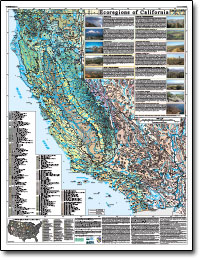
Ecoregions of California
Links
- Sheets:
- Download citation as: RIS | Dublin Core
Abstract
Ecoregions denote areas of general similarity in ecosystems and in the type, quality, and quantity of environmental resources. They are designed to serve as a spatial framework for the research, assessment, management, and monitoring of ecosystems and ecosystem components. By recognizing the spatial differences in the capacities and potentials of ecosystems, ecoregions stratify the environment by its probable response to disturbance (Bryce and others, 1999). These general purpose regions are critical for structuring and implementing ecosystem management strategies across Federal agencies, State agencies, and nongovernment organizations that are responsible for different types of resources in the same geographical areas (Omernik and others, 2000).
The approach used to compile this map is based on the premise that ecological regions are hierarchical and can be identified through the analysis of the spatial patterns and the composition of biotic and abiotic phenomena that affect or reflect differences in ecosystem quality and integrity (Wiken, 1986; Omernik, 1987, 1995). These phenomena include geology, physiography, vegetation, climate, soils, land use, wildlife, and hydrology. The relative importance of each characteristic varies from one ecological region to another regardless of the hierarchical level. A Roman numeral hierarchical scheme has been adopted for different levels of ecological regions. Level I is the coarsest level, dividing North America into 15 ecological regions. Level II divides the continent into 50 regions (Commission for Environmental Cooperation Working Group, 1997, map revised 2006). At level III, the continental United States contains 105 ecoregions and the conterminous United States has 85 ecoregions (U.S. Environmental Protection Agency, 2013). Level IV, depicted here for California, is a further refinement of level III ecoregions. Explanations of the methods used to define these ecoregions are given in Omernik (1995), Omernik and others (2000), and Omernik and Griffith (2014).
California has great ecological and biological diversity. The State contains offshore islands and coastal lowlands, large alluvial valleys, forested mountain ranges, deserts, and various aquatic habitats. There are 13 level III ecoregions and 177 level IV ecoregions in California and most continue into ecologically similar parts of adjacent States of the United States or Mexico (Bryce and others, 2003; Thorson and others, 2003; Griffith and others, 2014).
The California ecoregion map was compiled at a scale of 1:250,000. It revises and subdivides an earlier national ecoregion map that was originally compiled at a smaller scale (Omernik, 1987; U.S. Environmental Protection Agency, 2013). This poster is the result of a collaborative project primarily between U.S. Environmental Protection Agency (USEPA) Region IX, USEPA National Health and Environmental Effects Research Laboratory (Corvallis, Oregon), California Department of Fish and Wildlife (DFW), U.S. Department of Agriculture (USDA)–Natural Resources Conservation Service (NRCS), U.S. Department of the Interior–Geological Survey (USGS), and other State of California agencies and universities.
The project is associated with interagency efforts to develop a common framework of ecological regions (McMahon and others, 2001). Reaching that objective requires recognition of the differences in the conceptual approaches and mapping methodologies applied to develop the most common ecoregion-type frameworks, including those developed by the USDA–Forest Service (Bailey and others, 1994; Miles and Goudy, 1997; Cleland and others, 2007), the USEPA (Omernik 1987, 1995), and the NRCS (U.S. Department of Agriculture–Soil Conservation Service, 1981; U.S. Department of Agriculture–Natural Resources Conservation Service, 2006). As each of these frameworks is further refined, their differences are becoming less discernible. Regional collaborative projects such as this one in California, where some agreement has been reached among multiple resource-management agencies, are a step toward attaining consensus and consistency in ecoregion frameworks for the entire nation.
Suggested Citation
Griffith, G.E., Omernik, J.M., Smith, D.W., Cook, T.D., Tallyn, E., Moseley, K., and Johnson, C.B., 2016, Ecoregions of California (poster): U.S. Geological Survey Open-File Report 2016–1021, with map, scale 1:1,100,000, https://dx.doi.org/10.3133/ofr20161021.
ISSN: 2331-1258 (online)
Study Area
| Publication type | Report |
|---|---|
| Publication Subtype | USGS Numbered Series |
| Title | Ecoregions of California |
| Series title | Open-File Report |
| Series number | 2016-1021 |
| DOI | 10.3133/ofr20161021 |
| Publication Date | February 23, 2016 |
| Year Published | 2016 |
| Language | English |
| Publisher | U.S. Geological Survey |
| Publisher location | Reston, VA |
| Contributing office(s) | Western Geographic Science Center |
| Description | 2 Sheets: 36.00 x 47.00 inches |
| Country | United States |
| State | California |
| Online Only (Y/N) | Y |
| Additional Online Files (Y/N) | Y |

